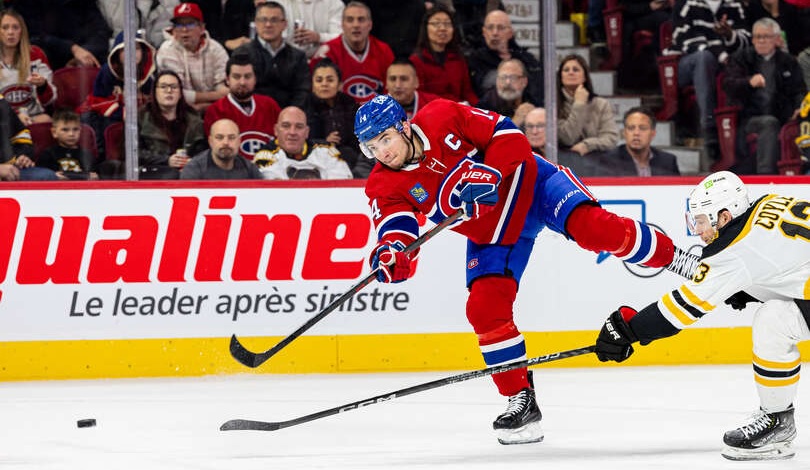Nick Suzuki – is he a first-line centre or not?
There is no question Suzuki is the top centre and the best all-around player for the Habs. In an injury-riddled season, Suzuki has played in every game, every situation, while setting career highs in points and playing with a large variety of linemates. There is no question he makes the players around him better.
But as he has now finished his first year of his mammoth $7.8M/year contract, is he living up to the deal? And more importantly, how does he compare to other top centres in the league? Is Suzuki a legitimate first-line centre in the NHL?
Using stats from NHL.com and moneypuck.com. I’ve assembled a number of stats from the top 50 centres (in total points) from the 2022-2023 season. The list starts at Connor McDavid, ends with Kevin Hayes, and includes centres from 30 of the 32 NHL teams with only Columbus and Arizona centres not making the cut. It’s entirely possible that some centres have been missed but I’ve done my best to try and capture the list thoroughly. (If the table below doesn’t display properly, click here to view it as an image.)
Looking at the more individual stats (you can click on the image above to make it larger), Suzuki looks to be in good company, largely ranking in the middle of the pack in goals, assists, points, and faceoff winning percentage. Surprisingly, he compares reasonably well in takeaways and giveaways which was a little bit of a surprise to me as I had expected him to fare worse in these metrics.
But these are individual stats so to look at how he does when playing against other top centres we need to look at the +/-, Corsi (shot attempts differential at even strength), and Fenwick (non-blocked shot attempts at even strength). It’s here we see Suzuki’s rankings near the bottom of the list.
At first glance, Suzuki’s Corsi and Fenwick results coming in at 49% (meaning teams are pretty close to being evenly matched in terms of shots attempts while Suzuki is on the ice) doesn’t seem that bad. But when you step back to think about it, teams need their top centres to control the play if they are to be competitive. Some of the top Corsi and Fenwick results include Jack Hughes (63%), Sebastian Aho (63%). and Patrice Bergeron (62%) who all controlled the puck over 60% of the time when they are on the ice. The average was 57% for all 50 centres, so Suzuki isn’t even close yet to matching the best centres.
And Suzuki’s -13 stat tells the same story that the team gets scored on more often than they score when Suzuki is on the ice.
Certainly, it’s a team game and there are a lot of variables to consider (i.e., quality of linemates and the team, goaltending, coaching, etc.) but it’s pretty clear that while Suzuki is Montreal’s #1 centre, he would not be #1 on most teams.
It’s important to note though that Suzuki was #1 in games played and #6 in time on ice so he certainly was exposed to more game play than other top centres. Much of this is due to the astronomically high number of injuries the Habs sustained this year. Perhaps as team depth improves, we’ll see Suzuki’s playing time decrease which might allow him to focus on more quality minutes.
Are the Habs getting a reasonable performance from Suzuki’s contract?
Trying to compare contract value is a very subjective process so I’ll try looking at things in a few ways.
For starters, the average cap hit for the top 50 centres is $6.49M. Suzuki’s $7.875M AAV is well above average and is the 18th highest of the top 50 centres.
In terms of performance, the average point total for the top 50 centres was 76. Taking into consideration the average cap hit that equates to ~$80K per point, Suzuki’s $7.8M contract with 66 points pays him $119,000 per point so he’s well above average again.
Let’s have a closer look at the players performing at a similar level to Suzuki. Using Suzuki’s 66 points as a midpoint, there were 18 centres +/- 5 points starting with Bo Horvat to Joel Eriksson Ek. Those players have an average salary of $5.6M, an average of $86K/point, and a Corsi rating of 55%. When compared to Suzuki’s performance, things continue to look bad for Nick.
Now of course points aren’t everything that matters. To repeat what was previously stated, a team wants their top centre to be driving play and thus have a strong Corsi rating. Having a look at the players with Corsi ratings below 55%, there were 17 centres with an average salary of $5.7M.
Let’s look at it another way starting with salary. With Suzuki’s contract as a midpoint, let’s look at all players with salaries +/- $1M. There are 15 players in that range starting with Sidney Crosby and ending with Nazem Kadri. (Even without seeing the results, just hearing those names in comparison to Nick Suzuki I already know what the data is going to show.) Anyways – these players have an average of 78 points and a 58% Corsi rating.
And that’s it folks. Anyway we want to look at it, realistically the Habs didn’t get good value in the first year of the eight-year deal. Suzuki is being paid well above average and unfortunately, his performance level ranked near the bottom. One of the biggest reasons for optimism is that over the first few years of his NHL career, Nick Suzuki has improved significantly each and every year. If the trend continues, the contract may turn out to be a reasonable, or even good, value down the road. For Habs fans, let’s hope this is the case.
